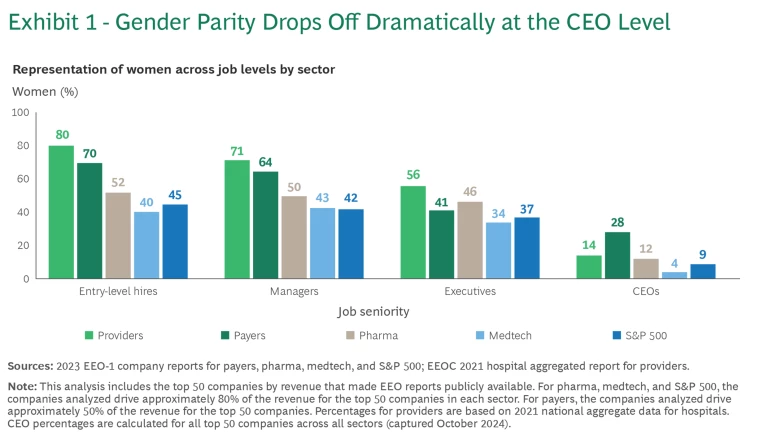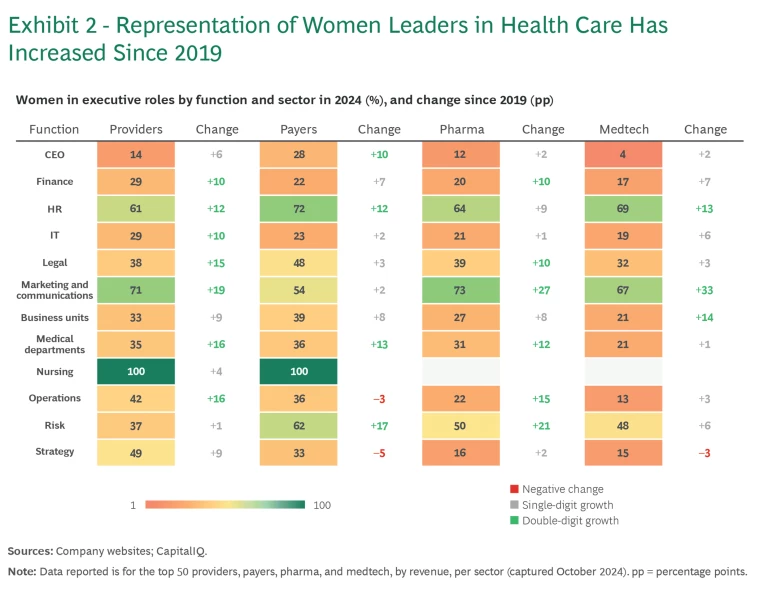It is well known that gender diversity in leadership drives better financial outcomes, improves patient care , and leads to more innovation . In the health care industry , women have reached parity at nearly all levels, from entry-level to executives (we define executives as leaders serving either one or two levels below CEO)–an enormous accomplishment. However, a glass ceiling continues to block access to the role of CEO itself, as men still dominate health care's top ranks: 85% of health care CEOs are male.
Over the past five years, since we last looked at this topic , a lot has happened: the COVID-19 crisis, widespread employee burnout, and wavering organizational commitments to diversity, equity, and inclusion (DEI). In the wake of these changes, we wanted to investigate how advancement opportunities and parity for women leaders in health care have evolved since 2019.
In addition to looking at the data, we asked top women executives in health care to discuss the challenges they face in the industry and the steps that they believe health care organizations can take to increase gender parity at the highest levels. By listening to the real stories of these women executives—and understanding the hurdles they’ve overcome—companies can make the bold moves necessary to support the advancement of women all the way to CEO.
Where We Stand Now
Our analysis of a representative subset of companies across key health care sectors—payers, providers, pharma, and medtech—shows that women make up nearly 50% of entry-level, managerial, and executive roles. If we ignore the CEO level, payers, providers, and pharma outperform the S&P 500 average in terms of gender parity at all three of those levels, while medtech lags the S&P 500 in most categories. At the CEO level, however, only ~15% of health care companies are led by women. (See Exhibit 1.)

A significant drop-off occurs across all health care sectors in the percentage of women executives versus women CEOs: a decline of 14 percentage points for payers (from 41% to 28%), 31 percentage points for medtech (from 34% to 4%), 42 percentage points for providers (from 56% to 14%), and 44 percentage points for pharma (from 46% to 12%). The decline is particularly notable among providers (health systems, not physicians), given that women fill over 80% of entry-level positions, but just 14% of CEO roles.
Despite the poor numbers at the CEO level, every health care sector has increased its percentage of women CEOs since 2019—a very encouraging development. Payers lead all health care sectors with 28% women CEOs, triple the S&P 500 average of 9%. Medtech is the farthest from parity, with just 4% women CEOs.
Although providers and pharma have seen fairly uniform increases in female representation across functions since 2019, payers and medtech have registered slightly more mixed results. (See Exhibit 2.) Across specific health care functions, women executives in all sectors have reached or surpassed 50% parity in human resources, nursing, and marketing and communications. Notably, these functions tend to be less well-compensated, and research shows that when women enter fields in greater numbers, the average level of pay goes down. Meanwhile, women executives continue to be underrepresented in the areas of IT, finance, medical departments, operations, strategy, and risk.

The Path Forward
Organizations need to establish better structures to promote women and to provide strong advancement opportunities. In our interviews with women who have reached senior leadership in health care, we asked them to consider what measures accelerated or slowed their journey to the top. Their responses highlighted five high-priority actions that can help more women reach the CEO level.
Create powerful mentorship networks. Women leaders emphasized the crucial role of mentorship, sponsorship, and coaching in their career advancement. Women need peers to test their ideas, mentors to guide their decision making, sponsors to pull them through the ranks, and coaches to help them address specific challenges along the way. One of our interviewees said, “My journey in soft skills was a lot longer because I had no one to coach me on leading with influence instead of authority. I had to learn how to ask questions without asserting my opinion.”
Responsibility for such mentorship should not fall solely on women. If one woman leader oversees dozens of women who need mentors, she will have to devote disproportionate time to that role, which will take time away from other activities. Men can and should play an active role in advocating for women’s advancement, particularly in light of their disproportionate representation in leadership roles. Kate Walsh, Massachusetts Secretary of Health and Human Services, pointed out, “The best male leaders should understand that if 70% of the organization is female, their leadership team should reflect that.”
Reward competence over confidence. Our interviewees noted that women primarily strive to demonstrate competence, while men are more likely to demonstrate confidence— which can be erroneously conflated with competence and effectiveness . The resulting perception bias tends to favor men in environments where company performance evaluations lack clear measurable objective criteria for advancement. Some of the women we interviewed expressed frustration about this, pointing out that men who may appear more confident than their female counterparts in meetings may not be more effective in their actual roles. To counteract unconscious bias, companies need to establish clear, standard objective criteria for measuring effective performance.
Without objective assessment criteria, success often depends more on who a candidate for promotion knows than what the candidate knows. In male-dominated work environments, women already spend an inordinate amount of time attempting to fit in—thinking about where to sit at the table, what to wear, when to speak up, how loudly to speak. Establishing more objective mechanisms to support workplace advancement will enable women to succeed on the basis of their accomplishments. One of our interviewees noted that some women may be afraid to lead with confidence because doing so comes across as “bossy”—but it takes a lot of effort to be viewed as serving more than just a supportive role.
Break down barriers that women face. Companies should approach DEI as they would any other business initiative, with KPIs that are measurable and have a set time frame. This will enable leaders to monitor the success of various initiatives and learn what works. Companies should also keep track of recruiting and retention statistics, and ensure that gender equity prevails in pay, promotion, and retention.
Companies have embraced DEI at varying levels—some doubling down while others pull back—but the women we interviewed universally favor formal DEI processes. Tina Freese Decker, president and CEO of CoreWell Health, described the value of DEI in her company this way: “We implemented a set of guiding principles for what we wanted to accomplish in DEI, including business review groups, training and development programs, performance reviews, financial metrics, and other measures to gauge the effectiveness of our DEI efforts. Companies need to be guided by the data to ensure they understand what initiatives are truly making a difference and have a positive impact.”
Organizations can also implement specific measures as part of a formal process to ensure gender diversity for new board member nominations and succession planning. One executive said, “Gender diversity is very much a part of our DEI conversations. When we talk about nominating new members to the board, we discuss percentages to find the right mix. When we talk about top-tier succession planning, we ensure diversity is a part of it. DEI is a part of the everyday vernacular.”
Offer flexible work arrangements. Flexible work arrangements can make a big difference, particularly for working mothers. Jennifer Eslinger of Rochester Regional Health said, "The industry as a whole is so workforce-challenged right now, we have got to rethink the way that we retain talent. There is still a certain level of judgment of part-time versus full-time, flexible schedule, and working remotely. But we don't need to worry about how many days people are taking off, or how many days they are working remotely. Getting the work done is what's important—and we need to create space for that." Although the women we interviewed said that colleagues were sometimes critical of flexible working arrangements, such as remote work and flexible scheduling, the pandemic normalized flexible and hybrid work environments, which has helped reduce the “mother penalty.” Importantly, organizations that instituted policies to support employees’ work-life balance and ease burnout were better able to retain women at all levels. Stacey Malakoff, CFO of Hospital for Special Surgery added: “There are pros and cons to hybrid working, but one of the pros is that it’s easier to be home in time to put your child to bed or to attend a school event. The downside is that it’s harder than ever put your device away so you can be fully present.”
Encourage open conversations about life beyond work. Leaders—both men and women—should normalize conversations about their family responsibilities. When women are the only ones talking about balancing work and family, it becomes a “woman’s issue,” which is ultimately detrimental to all. Niki Robinson, vice president and COO at Fred Hutchinson Cancer Center, said, “I've worked with many men who are very open about their lives and their families—and I just think they're so much better for it.”
Leaders should also normalize bringing their authentic self to work—and encourage others to do the same. Executives have many opportunities to connect with employees, whether by making the rounds on the hospital floor, organizing small groups for women returning from maternity leave, or participating in a formal mentorship group. Creating authentic connections enables employees to feel comfortable asking questions, seeking advice, and opening up about their career goals. When asked what advice she had for aspiring leaders, CoreWell Health’s Decker said: “It’s OK to be real. It’s OK to be your authentic self. Connection with others who have similar lived experiences is invaluable. Women need to know that they have a group of people cheering them on to put themselves out there and take that next step.”
Though the health care industry has made strides since 2019, true gender parity at the CEO level remains elusive. In addition, women consistently earn less than men at all levels, regardless of role, education, or experience.
Besides talking about what organizations can and should do to accelerate gender parity in the C-suite, the women we interviewed offered advice for aspiring female health care leaders and future CEOs. Our interviewees agreed that women are usually much more capable and prepared than they give themselves credit for—but they may hesitate to apply for promotions. Eslinger said, “Be bold and brave. Don’t wait, and put yourself out there. Seek out the advancement opportunities for growth. Know your worth. Women don’t actively seek out opportunities for growth, assuming that it will just happen if we put in the hard work—but that assumption can be misguided.” Kate Walsh, Massachusetts Secretary of Health and Human Services, echoed similar advice for women leaders: "Take the risky position that everyone tries to talk you out of. Get comfortable in your own skin. Know your worth and be an authentic leader."
The authors would like to thank Cayetana Llano, Fresia Blanco, and Shalini Pammal for their contributions to this article.












